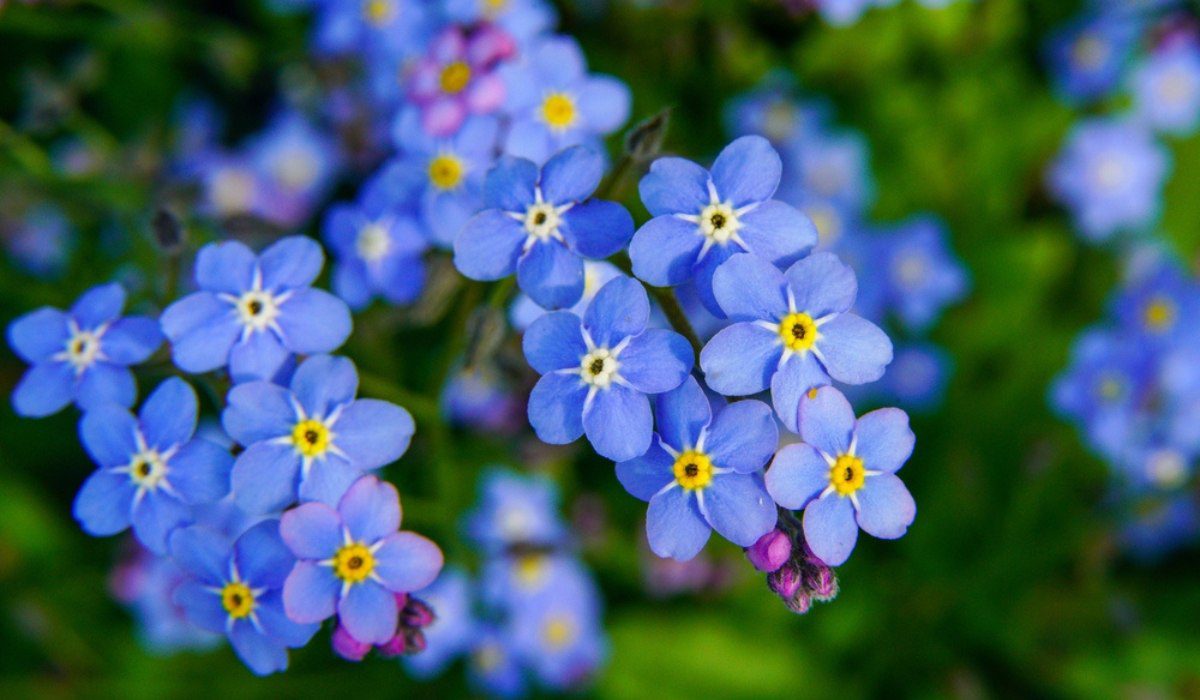These delicate blossoms belong to the Myosotis genus within the Boraginaceae family. Despite some variations within the species, most of these flowers boast a modest size, measuring approximately half an inch in diameter. Characterised by five petals that gracefully unfurl at the stem’s terminus, forget-me-nots are widely recognised for their predominantly blue hue, though certain cultivated varieties showcase pink or white blooms or even a delightful mix of colours.
They find their place harmoniously in informal garden borders and mixed containers. The foliage of forget-me-nots not only adds visual appeal but also proves resilient against deer and rabbits, boasting a resemblance to rounded mouse ears. Additionally, these blossoms serve as nature’s invitation to birds and butterflies, enhancing the vitality and vibrancy of your yard.
See also: Asparagus Setaceus: Tips to grow, care
Forget Me Not Flower: Key facts
| Botanical name | Myosotis sylvatica |
| Common name | Yelloweye forget-me-not, Forget-me-not |
| Family | Boraginaceae |
| Native area | Alaska, Dalsland, North America, South America |
| Flower size | 4-12 inch |
| Sun exposure | Full or partial sun exposure |
| Soil type | Moist Soil |
| Flower colour | Blue, Pink, White, Yellow |
| Toxic | Low-Toxicity |
Forget Me Not Flower: How to care for?
- Lighting: Forget-me-nots prefer full sun but appreciate some afternoon shade in hot summers.
- Soil and Water: They thrive in consistently moist, well-drained soil and can tolerate wet conditions. Some of these species can also even grow in stagnant water.
- Temperature and Humidity: Forget-me-nots handle a range of temperatures but dislike high heat and humidity, especially in the South. Consider them as cool-season annuals or choose heat-tolerant varieties.
- Fertiliser: Apply a slow-release all-purpose fertilizer, like 10-10-10, annually in spring. Follow the product guidelines for the right amount.
- Pruning: Prune forget-me-nots only to control reseeding, and they look best when planted in large groups.
- Potting and Repotting: Though typically ground cover, forget-me-nots can be potted. Use well-draining soil in a container with proper drainage. Water consistently, pinch off fading blooms for new growth, and keep them in a cool, not too hot, sunny spot.
Forget Me Not Flower: How to grow?
In places where it gets really cold in winter, plant forget-me-not seeds outside a few weeks before the last frost. If you want them to bloom in the same year, start the seeds indoors about eight to 10 weeks before the last frost. In milder areas, just sow the seeds in the fall for flowers in the spring.
Forget-me-nots are easy to grow. Just give them good soil, water them regularly and put them in a spot with some shade. They like soil that stays a bit moist but drains well, and they do best where it is not too hot in the summer.
You can grow woodland forget-me-nots in pots as long as you make sure they get the right amount of water, soil, and light. The regular kind of forget-me-nots can also grow in pots with a bit of water at the bottom. This gives you more options for adding these pretty flowers to your space.
Forget-Me-Not Flower: Types
- Wood Forget-Me-Not – The Wood Forget-Me-Not, an exquisite flower, graces the landscape from mid-spring to mid-summer, displaying a vibrant array of colours such as vivid blue, pink, or white, each adorned with delicate white or yellow eyes.
- Victoria Rose – Although all Forget-Me-Nots hold beauty, the Victoria Rose variety stands out with its enchanting pink or dusty rose hues. These blooms captivate with eyes that shimmer in shades of yellow, bordering on a golden allure.
- Field Forget-Me-Not – Hailing from Asia but now widespread in North America, the Field Forget-Me-Not predominates in the northern and eastern regions. Its blossoms, characterised by traditionally light blue petals and a central yellow eye, grace the landscape.
- Water Forget-Me-Not – Flourishing in the wetlands of North America, particularly in New England, Water Forget-Me-Nots thrive in moisture-rich habitats like lakes and rivers. Radiating shades of blue and purple, these perennial flowers boast the elegance of five delicate petals.
- Alpine Forget-Me-Not – Recognised as Scorpion Grass, Alpine Forget-Me-Nots, abundant in the United Kingdom, find their home in basic rock formations, meadows, and damp woodlands across the United States. Spring heralds their arrival, lasting through early summer.
- Tufted Forget-Me-Not – Also known as Bay or Small Flower Forget-Me-Nots, the Tufted Forget-Me-Not distinguishes itself with a unique hue bordering on white. In addition to the traditional shades of blue, these blossoms can be found in captivating tones of red, purple and dark blue.
- Strict Forget-Me-Not – In contrast to the typical blue hues of Forget-Me-Nots, the Strict Forget-Me-Not, often referred to as Blue Forget-Me-Nots, adorns parts of North America with its delightful light blue blooms. Among the Forget-Me-Not family, they are notably easy to cultivate.
- Changing Forget-Me-Nots – The aptly named Changing Forget-Me-Nots undergo a transformation in colour during their blooming season. Beginning with a yellow or cream hue, they transition to pink before culminating in blue.
- Early Forget-Me-Not – Unlike many of its counterparts originating in Asia, the Early Forget-Me-Not is believed to trace its roots to the northern reaches of the United Kingdom. Thriving in colder climates, these blooms exhibit resilience in chilly environments.
- Lapland Forget-Me-Not – Hailing from Northern Finland, the Lapland Forget-Me-Not finds its natural habitat in cold surroundings. Flourishing in woodlands and areas with small springs, these flowers demand consistently moist soil for optimal growth when introduced to your yard.
Forget-Me-Not Flower: Common problems when growing
- Detecting aphids early is crucial. These small, sap-sucking pests resemble tiny potatoes and anchor themselves to plant leaves. Regular inspections help. Manage aphids with water sprays or manual removal.
- Potato flea beetles, resembling seeds, feed beneath leaves. They are not major forget-me-not pests. Use row covers for young plants to ward them off.
- Slugs and snails, notorious garden pests, can be controlled. Nightly checks ensure damage attribution. Once identified, take precise corrective measures.
Forget-Me-Not Flower: Toxicity
This plant, though possessing relatively low toxicity, harbors pyrrolizidine, a chemical of mild toxicity. Ingesting substantial amounts thereof may precipitate weight loss, compromised health and liver illnesses. In the event of accidental consumption, if you feel discomfort, urgently consult with medical personnel.
FAQs
What is the life cycle of forget-me-not?
Most varieties of Forget-Me-Not follow a biennial life cycle, serving as short-lived perennials. In the initial year, they begin their growth, blossoming and concluding their life cycle in the subsequent year. Although regarded as perennials due to their prolific self-seeding, they reappear annually.
Is forget-me-not suitable as an indoor plant?
Certainly, forget-me-nots can be cultivated in containers, making them ideal for enhancing confined spaces like patios or screened porches. Additionally, these flowers can be potted and enjoyed indoors, providing versatility in their placement.
Does Forget Me Not return each year?
Indeed, most forget-me-not varieties are perennials, persistently returning and expanding through both seeds and stolons. Renowned for their robust spreading, especially near the Great Lakes in the US, they have earned a reputation as an invasive species in those regions.
Where does forget-me-not thrive best?
Forget-me-nots flourish optimally in partial shade within hardiness zones five through nine, as per our experts' insights. Their natural habitat encompasses shady woodlands and riverbanks, where they thrive and contribute to the ecosystem.
Is Forget Me Not categorised as a flower or a plant?
Forget-me-not, scientifically known as Myosotis, is a modest yet magnificent spring flower. It graces borders and path peripheries with ethereal blue clusters. Its versatility shines as it complements taller tulips or wallflowers, effortlessly naturalising in wilder-style plantings.
What type of fertiliser is recommended for flowers?
The ideal flower plant fertiliser should contain primary macronutrients, namely nitrogen, phosphorus, and potassium. These are essential in larger quantities compared to other nutrients. Secondary macronutrients, such as magnesium, calcium, and sulfur, further contribute to a balanced and nourishing fertiliser.
Can forget-me-nots be found in India?
Forget-me-nots are prevalent in Europe, Asia, and the Americas, thriving in habitats along shady streams, creeks, and wet areas. Notably, the Chinese forget-me-not is indigenous to China and can also be found in India.
| Got any questions or point of view on our article? We would love to hear from you. Write to our Editor-in-Chief Jhumur Ghosh at jhumur.ghosh1@housing.com |






